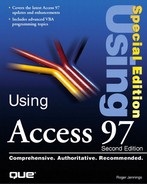Chapter 2. Building Your First Access Application
Unlike other members of Microsoft Office 97, Access 97 requires that you build an application to take advantage of the product's power as a database development platform. Word 97 and Excel 97 let you automate simple repetitive operations by recording Visual Basic for Applications (VBA) macros. Access 97 supports a set of macro commands for compatibility with previous versions, but Access macros don't use VBA. (Access macros aren't recommended for new database applications.) Access doesn't capture your mouse clicks and keystrokes and turn them into a series of macro commands or VBA code. Thus, it's up to you to design and implement the Access applications you need for your database projects.
A full-scale Access application involves at least the following three basic Access object types:
Tables that store the data you or others add to the database
Forms for displaying and entering data, controlling the opening and closing of other forms, and printing reports
Reports to print detail information, summary information, or both in tables
Most Access applications also use Query objects to filter, sort, and combine your data, and Module objects to store VBA code. Access 97 forms can (and usually do) contain VBA code in a special type of Module object, called a Class Module. All objects that make up your application are stored in a container called a Database object, which is a single file with an .mdb extension, such as Northwind.mdb. Access is unique in that it stores an entire database application in a single file. Other desktop databases, such as Microsoft FoxPro, require multiple files to store their objects.
New Access users often find it difficult to "get a grip" on how to start developing a self-contained database application. Dealing with an unfamiliar set of objects tends to intimidate first-time database developers. Fortunately, Microsoft includes with Access 97 various wizards that guide you, step by step, through complex tasks. One of the most accomplished of the Access wizards is the Database Wizard that creates a typical Access 97 application from a set of prefabricated database templates. In this chapter, you use the Database Wizard to create a relatively simple but potentially useful Contact Manager application. Then you explore the objects generated by the Wizard to gain perspective on the relationship of Access objects and learn how they are integrated within a typical Access database application.
Note
This chapter assumes that you've already installed Access 97. If you haven't, see the Installing Access 97 section of Chapter 1, "Access 97 for Access 95 and 2.0 Users: What's New."
